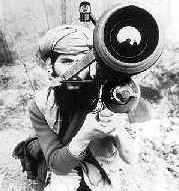- Types of Air Superiority
Frequently Asked Questions
![]()
Questions for This Section
Ask a Question
Table of Contents
1)
Hand-held SAMs seem to be the way of the future, right? A Stinger is just as good as SA-8 but weighs a lot less and can be transported more easily. And, of course, is harder to recognise. From the POV of an attack aircraft pilot, a man with a Stinger is basically the same as a man with a MILAN or an M-60.Yes, handheld SAMs change things. They give infantry the ability to fight back. The wave of the future? Probably not. They will, however, continue to evolve alongside aircraft. You see, handheld SAMs have their limitations.
First of all is that, because of their small size, they have a very short effective range, usually less than six kilometers, and a very small warhead - not enough to knock down an A-10 or Su-25, much less a bomber, with a single hit. They also must be infrared guided, meaning that they can be decoyed by flares, or even the sun. IR guidance also makes them dangerous - they might not lock onto the A-10, but rather to the MiG-29 trying to shoot it down. Most friendly fire casualties in aerial operations are caused by IR missiles in this way.
IR missiles can also be defeated by flashing a laser light on their seeker head while in flight, thusly "blinding" them. The US, Britain, Russia, and several other countries are working on placing laser devices on their aircraft. The RAH-66 Comanche will have such a device.
So, while dangerous, handheld SAMs are far from perfect. They can be, however, very dangerous to a pilot who isn't on his toes.
2)
What if a fifth-generation -calling the Stinger a third-generation- weapon appears? Something that can surmount all the other problems. New technology and better microchips. And a warhead of better explosives, condensed explosives -perhaps even a tiny nuclear charge- that is capable of blasting whatever it has to?Well, beyond the cost issue, which would probably be a large one, it still has the basic limitations of a missile. Because they travel at such high speeds, they have rather poor maneuverability, even when using vectored thrust systems. A good pilot can evade a good missile most of the time. Also, remember that the same technology used to make the missile will have been applied to aircraft as well - improved thrust vectoring, better microchips and sensors, and the like. It would cause a stir and do some damage (just like the SA-6 when it first appeared on the Golan in 1973), but tactics to beat it would eventually appear. This will lead to a better missile, which will lead to a better aircraft, which will lead to a better missile, and so forth. The same sort of duel happened between knights and archers in the Middle Ages, if I recall correctly (until the crossbow started wiping knights out left and right, but that's another story).
3)
The Russians had total AS in Afghanistan, with no restrictions, and lost. And even had the Americans full SAS with no restrictions in Vietnam, had they fought the same way on the ground, they would have lost the same way. Desert and plains are good for aircraft. Jungle and mountains are territory that aircraft have a very minimal effect on.And yet Kosovo is very mountainous, and NATO aircraft savaged the Yugoslavian forces there. However, you do bring up good points. Let me qualify my statements - you cannot win a conventional war without AS. Guerrilla warfare is a different way of doing things and is outside the realm of the normal rules of warfare. However, it's only tangentally related to what we're talking about, so I won't get into airpower's place in guerrilla wars yet.

The Stinger handheld SAM was responsible for the destruction of literally hundreds of Soviet planes during the war in Afghanistan.

NATO proved the true destructive potential of conventional airpower over any terrain during the bombing campaign in Kosovo.